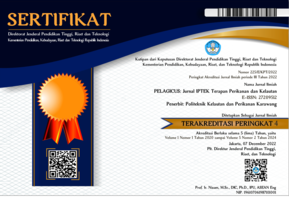Structure of Plankton Communities on The Kalianda Coast, South Lampung
Abstract
The presence of plankton is very important for aquatic ecosystems. Kalianda Coastal Beach has direct access to the open sea. Its water condition can experience changes including physical, chemical, and biological conditions. Moreover, the beaches in the Kalianda coastal area are widely used for vannamei shrimp breeding, ferry port, fishery and trade port. The purpose of this study was to evaluate the structure of the plankton community, including abundance and species composition, diversity index, uniformity, and dominance. This study used data from water sources in three vannamei shrimp nurseries located in Kalianda Coastal Beach, South Lampung. Water parameters observed in Kalianda Coastal were plankton, salinity, pH, nitrate, ammonia, dissolved solids (TSS), and phosphate. The results showed that the plankton found in Kalianda coastal area consisted of four classes, phytoplankton namely Bacillariophyceae (78.75%) and Dynophyceae (9.85%), zooplankton Ciliata (7.79%) and Crustacea (3.61%). The range of phytoplankton abundance is 2392-3029 cells/l, while the abundance of zooplankton is 279-414 ind/l. Plankton diversity and uniformity indices are high meaning that the plankton community in Kalianda Coast is very diverse and stable, low dominance means that there are plankton that dominate, namely from the Bacillariophyceae class. The structure of the plankton community in Kalianda Coastal Beach shows a stable condition at the time of the research. To know the plankton community structure more thoroughly, it is necessary to take plankton samples every season with more station points.
Keywords
Full Text:
PDFReferences
Andriyani, N., Mahdiana, A., Hilmi, E., & Kristian, S. (2020). The Correlation Between Plankton Abundance And Water Quality in Donan River. Omni-Akuatika. https://doi.org/10.20884/1.OA.2020.16.3.844.
Anggara, AP., Kartijono, N E., Bodijantoro, P M H. 2017. Keanekaragaman plankton di kawasan cagar alam Tlogo Dringo, Dataran Tinggi Dieng, Jawa Tengah. Jurnal MIPA 40 (2): 74-79.
Astriana, B., & Larasati, C. (2021). Diversitas Plankton di Perairan Pantai Sire Kabupaten Lombok Utara. Jurnal Ilmu Kelautan Lesser Sunda. https://doi.org/10.29303/jikls.v1i1.26.
Daigle, D, 2003. Nutrient pollution in coastal waters. Multinational Monitor.
Efrinaldi, 2006. Kondisi komunitas zooplankton di Perairan teluk Hurun Lampung. Skripsi. Institut Pertanian Bogor.
Grizzetti, B. et.al, 2021. How EU policies could reduce nutrient pollution in European inland and coastal waters. Global Environmental Change (69) 102281.
Hadi.1993. Metodologi Research, Penulisan Paper, Skripsi, Thesis dan Disertasi. Yayasan Penerbit Fakultas Psikologi Universitas Gajah Mada. Yogyakarta. 218 hal.
Heshmatpour, A., pasand, s., Sabouri, H., & Rostami, F. (2019). Evaluation of water pollution from rice cultivation using Nitrogen fertilizer in North of Iran. 7, 20-28. https://doi.org/10.22069/IJERR.2019.13545.1211.
Idiawati, N., Safitri, I., & Sofiana, M. (2021). Community structure and diversity of phytoplankton in Lemukutan island waters, west Kalimantan. Saintek Perikanan : Indonesian Journal of Fisheries Science and Technology. https://doi.org/10.14710/ijfst.17.2.122-129.
Jadhao, R. (2013). Contamination Of Water By Nitrate: A General Discussion Problems Associated, Causes, Prevention And Effects. International journal of innovative research and development, 2.
Kiedrzynska E, Kiedrzynski M, Urbaniaka M, Magnuszewski A, Skłodowski M, Wyrwicka A, Zalewski M, 2014. Point sources of nutrient pollution in the lowland river catchment in the context of the Baltic Sea eutrophication. Ecological Engineering (70) 337–348.
Langelier, W. (1928). The Quantitative Estimation of Plankton. Journal American Water Works Association, 19, 408-415. https://doi.org/10.1002/J.1551-8833.1928.TB13565.X.
Luo, S., Wu, B., Xiong, X., & Wang, J. (2016). Short‐term toxicity of ammonia, nitrite, and nitrate to early life stages of the rare minnow (Gobiocypris rarus). Environmental Toxicology and Chemistry, 35. https://doi.org/10.1002/etc.3283.
Mitra, A. (2013). Climate Change and Plankton Spectrum of Mangrove Ecosystem. , 161-190. https://doi.org/10.1007/978-81-322-1509-7_5.
Nyibakken, J.W. 1988. Biologi Laut. Suatu Pendekatan Ekologis. Penerbit PT.Gramedia. Jakarta
Odum, E.P. 1971. Fundamentals of Ecology. 3rd ed. W. B. Saunders Company. Philadelphia. . 1993. Dasar dasar Ekologi . Edisi ke III . Diterjemahkan oleh Tjahjono , S . Gajah Mada University Press. Yogyakarta : 201 – 250 hlm.
Pavithran, S., , N., & Sankaranarayanan, K. (2014). An analysis of various coastal issues in Kerala. International Journal of Scientific Research in Education, 2.
Peraturan Pemerintah RI no, 22 tahun 2021 mengenai baku mutu air laut untuk biota laut. https://peraturan.go.id/id.
Rahman,E.C., Masyamir dan Rizal A. 2016. Kajian Variabel Kualitas Air Dan Hubungannya Dengan Produktifitas Primer Fitoplankton Di Perairan Waduk Darma Jawa Barat. Jurnal Perikanan Kelautan Vol. VII No. 1/Juni 2016 (93-102).
Romano, N., & Zeng, C. (2013). Toxic Effects of Ammonia, Nitrite, and Nitrate to Decapod Crustaceans: A Review on Factors Influencing their Toxicity, Physiological Consequences, and Coping Mechanisms. Reviews in Fisheries Science, 21, 1 - 21. https://doi.org/10.1080/10641262.2012.753404.
Santhanam, P., Pachiappan, P., Begum, A. (2019). A Method of Collection, Preservation and Identification of Marine Zooplankton. In: Santhanam, P., Begum, A., Pachiappan, P. (eds) Basic and Applied Zooplankton Biology. Springer, Singapore. https://doi.org/10.1007/978-981-10-7953-5_1
Siregar, A. 2006. Analisis Spasial Struktur Komunitas Fitoplankton di Perairan Teluk Hurun, Lampung. Skripsi. Institut Pertanian Bogor.
Taxonomic Identification of Marine Phytoplankton. Basic and Applied Phytoplankton Biology. https://doi.org/10.1007/978-981-10-7938-2_2.
Teisl, M., Bell, K., & Noblet, C. (2017). Special Issue on the Economics of Changing Coastal Resources: The Nexus of Food, Energy, and Water Systems.. Agricultural and Resource Economics Review, 46, 175 - 185. https://doi.org/10.1017/age.2017.25.
Utojo, U., Mustafa, A., Rachmansyah, R., & Hasnawi, H. (2016). Penentuan lokasi pengembangan budidaya tambak berkelanjutan dengan aplikasi sistem informasi geografis di kabupaten lampung selatan. , 4, 407-423. https://doi.org/10.15578/JRA.4.3.2009.407-423.
Vassilev, N., Vassileva, M., & Nikolaeva, I. (2006). Simultaneous P-solubilizing and biocontrol activity of microorganisms: potentials and future trends. Applied Microbiology and Biotechnology, 71, 137-144. https://doi.org/10.1007/s00253-006-0380-z.
Welch, P. S. 1952. Limnological Methods. Mc Grow-hill Book Company Inc. USA.
Yamaji, I. 1979. Illustration of Marine Plankton of Japan. Hoikusha Publishing Co. Ltd. Japan. 5-197 pp.
Zhang, J., Geng, J., Ren, H., Luo, J., Zhang, A., & Wang, X. (2011). Physiological and biochemical responses of Microcystis aeruginosa to phosphite.. Chemosphere, 85 8, 1325-30. https://doi.org/10.1016/j.chemosphere.2011.07.049.
Zheng, Q., & Klemas, V. (2018). Coastal Ocean Environment, 8, 89-120. https://doi.org/10.1016/B978-0-12-409548-9.10518-4.
DOI: http://dx.doi.org/10.15578/plgc.v5i1.14058
Refbacks
- There are currently no refbacks.

This work is licensed under a Creative Commons Attribution-ShareAlike 4.0 International License.
E-ISSN: 2720-9512
ISSN: 2715-9620












